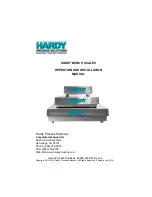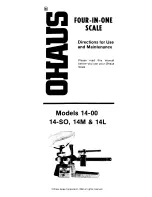
CHAPTER 3 REPAIR PROCEDURES
3.1.4 InCal Weight Hardware Disassembly & Testing
If the Weight Mechanism appears to be unstable, the first remedy should be to perform an InCal
Weight Mechanism test. This test is done with the Discovery Balance Software Service Tool
(see Appendix C, especially C.5 and C.6), installed on a personal computer which is connected
to the balance’s RS232 port using a standard serial extension cable.
Observe the weight displayed on the balance for each of the four conditions (No Load, Partial
Load 1, Partial Load 2, and Total Load). If the display does not stabilize after a few seconds in
each condition, this could be caused by a defect in the Weight Mechanism hardware – one or
both of the weights might not be fully lowered in their cradles, a part of the mechanism might
have come out of position, or dust or debris might have entered the mechanism.
Depending on the balance capacity, Error 8.3 (Weight reading above underload limit) may be
displayed when Total Load is applied. This is normal.
NOTE:
The following procedure should only be performed in a clean, dust-free
environment, which is also free of vibrations that could affect the ultra-sensitive
calibration of the balance.
To identify and correct any of these problems, use the following procedure to disassemble,
inspect and clean the InCal Weight hardware:
1. Remove the housing and open the balance. (Follow the steps in Section 3.1.1.)
2. Remove the 2 screws from the Display Cable Shield Plate and lift it aside.
Display Cable Shield Plate Screws
Figure 3-13. Removing Display Cable Shield Plate.
3. Carefully move the Display Cable to the side. It does not need to be disconnected
for this procedure.
Ohaus Corporation www.ohaus.com
3-10
Discovery Balance Service Manual
Содержание DISCOVERY BALANCE
Страница 2: ......
Страница 4: ......
Страница 10: ...TABLE OF CONTENTS Ohaus Corporation www ohaus com vi Discovery Balance Service Manual...
Страница 99: ...80104135 P N 80104135 SERVICE MANUAL DISCOVERY BALANCE...
















































